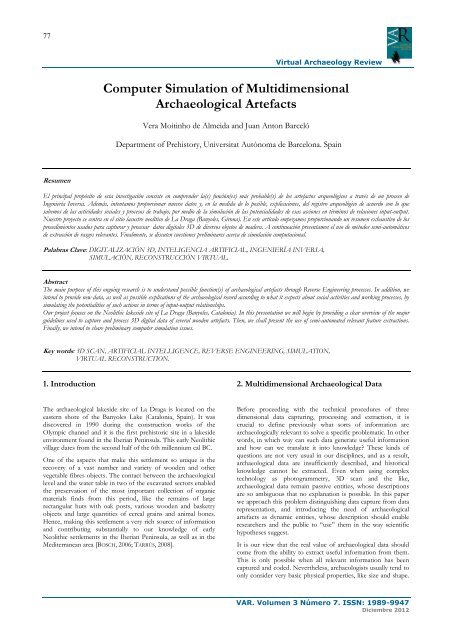Virtual Museums
Virtual Museums
Virtual Museums
You also want an ePaper? Increase the reach of your titles
YUMPU automatically turns print PDFs into web optimized ePapers that Google loves.
77<br />
Resumen<br />
<strong>Virtual</strong> Archaeology Review<br />
Computer Simulation of Multidimensional<br />
Archaeological Artefacts<br />
Vera Moitinho de Almeida and Juan Anton Barceló<br />
Department of Prehistory, Universitat Autònoma de Barcelona. Spain<br />
El principal propósito de esta investigación consiste en comprender la(s) función(es) más probable(s) de los artefactos arqueológicos a través de un proceso de<br />
Ingeniería Inversa. Además, intentamos proporcionar nuevos datos y, en la medida de lo posible, explicaciones, del registro arqueológico de acuerdo con lo que<br />
sabemos de las actividades sociales y procesos de trabajo, por medio de la simulación de las potencialidades de esas acciones en términos de relaciones input-output.<br />
Nuestro proyecto se centra en el sitio lacustre neolítico de La Draga (Banyoles, Girona). En este artículo empezamos proporcionando un resumen exhaustivo de los<br />
procedimientos usados para capturar y procesar datos digitales 3D de diversos objetos de madera. A continuación presentamos el uso de métodos semi-automáticos<br />
de extracción de rasgos relevantes. Finalmente, se discuten cuestiones preliminares acerca de simulación computacional.<br />
Palabras Clave: DIGITALIZACIÓN 3D, INTELIGENCIA ARTIFICIAL, INGENIERÍA INVERSA,<br />
SIMULACIÓN, RECONSTRUCCIÓN VIRTUAL.<br />
Abstract<br />
The main purpose of this ongoing research is to understand possible function(s) of archaeological artefacts through Reverse Engineering processes. In addition, we<br />
intend to provide new data, as well as possible explications of the archaeological record according to what it expects about social activities and working processes, by<br />
simulating the potentialities of such actions in terms of input-output relationships.<br />
Our project focuses on the Neolithic lakeside site of La Draga (Banyoles, Catalonia). In this presentation we will begin by providing a clear overview of the major<br />
guidelines used to capture and process 3D digital data of several wooden artefacts. Then, we shall present the use of semi-automated relevant feature extractions.<br />
Finally, we intend to share preliminary computer simulation issues.<br />
Key words: 3D SCAN, ARTIFICIAL INTELLIGENCE, REVERSE ENGINEERING, SIMULATION,<br />
VIRTUAL RECONSTRUCTION.<br />
1. Introduction<br />
The archaeological lakeside site of La Draga is located on the<br />
eastern shore of the Banyoles Lake (Catalonia, Spain). It was<br />
discovered in 1990 during the construction works of the<br />
Olympic channel and it is the first prehistoric site in a lakeside<br />
environment found in the Iberian Peninsula. This early Neolithic<br />
village dates from the second half of the 6th millennium cal BC.<br />
One of the aspects that make this settlement so unique is the<br />
recovery of a vast number and variety of wooden and other<br />
vegetable fibres objects. The contact between the archaeological<br />
level and the water table in two of the excavated sectors enabled<br />
the preservation of the most important collection of organic<br />
materials finds from this period, like the remains of large<br />
rectangular huts with oak posts, various wooden and basketry<br />
objects and large quantities of cereal grains and animal bones.<br />
Hence, making this settlement a very rich source of information<br />
and contributing substantially to our knowledge of early<br />
Neolithic settlements in the Iberian Peninsula, as well as in the<br />
Mediterranean area [BOSCH, 2006; TARRÚS, 2008].<br />
2. Multidimensional Archaeological Data<br />
Before proceeding with the technical procedures of three<br />
dimensional data capturing, processing and extraction, it is<br />
crucial to define previously what sorts of information are<br />
archaeologically relevant to solve a specific problematic. In other<br />
words, in which way can such data generate useful information<br />
and how can we translate it into knowledge? These kinds of<br />
questions are not very usual in our disciplines, and as a result,<br />
archaeological data are insufficiently described, and historical<br />
knowledge cannot be extracted. Even when using complex<br />
technology as photogrammetry, 3D scan and the like,<br />
archaeological data remain passive entities, whose descriptions<br />
are so ambiguous that no explanation is possible. In this paper<br />
we approach this problem distinguishing data capture from data<br />
representation, and introducing the need of archaeological<br />
artefacts as dynamic entities, whose description should enable<br />
researchers and the public to “use” them in the way scientific<br />
hypotheses suggest.<br />
It is our view that the real value of archaeological data should<br />
come from the ability to extract useful information from them.<br />
This is only possible when all relevant information has been<br />
captured and coded. Nevertheless, archaeologists usually tend to<br />
only consider very basic physical properties, like size and shape.<br />
VAR. Volumen 3 Número 7. ISSN: 1989-9947<br />
Diciembre 2012


